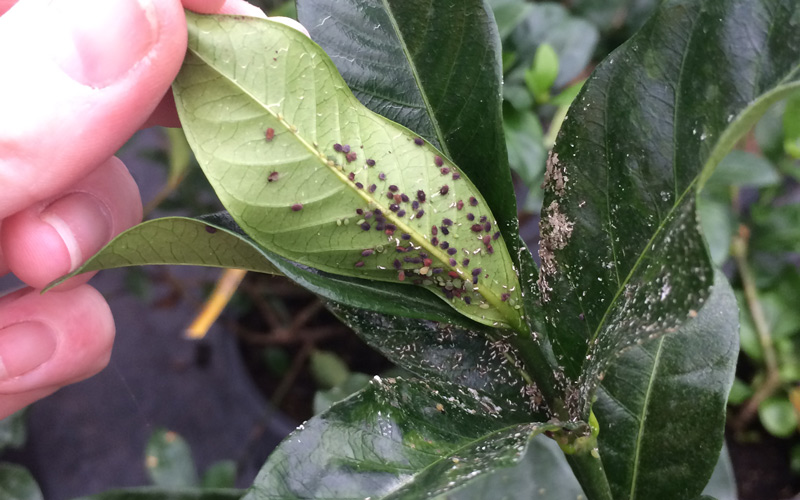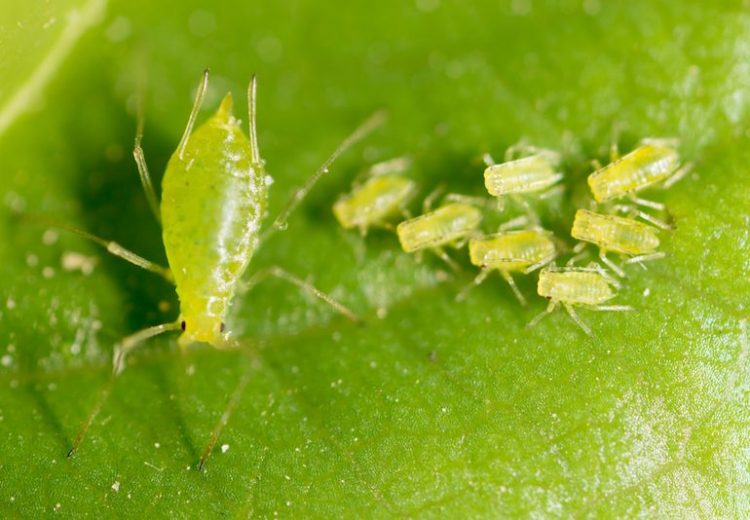How To Control Aphids On Indoor House Plants
Growing flowers and shrubs indoors has a lot of benefits, ranging from fresh air to improved home decor. However, the benefits can dwindle quickly when these houseplants are under attack by pests such as aphids. Aphids are small, sap-sucking insects that can cause a great deal of damage to plants.
They typically congregate on the undersides of leaves, feeding on plant sap. This can lead to reduced growth, wilting, and even leaf drop. Fortunately, there are several ways of controlling aphids on indoor plants. Keep reading.
What are Aphids?
These are small, soft-bodied insects that feed by sucking juices from plants. They are usually green or black and can be found on the undersides of leaves. Aphids can cause a great deal of damage to plants, leading to stunted growth and leaf drop. However, these insects move rather slowly, making indoor plants relatively easy aphid control.

Image credit: https://bdn-ss-hh.s3.amazonaws.com/
Identifying Aphids
Aphids are tiny insects that are nearly invisible to the naked eye. For instance, adult aphids are under ¼ inch and can be about any color from brown, red, and blue. Most aphid species can appear white, black, brown, grey, yellow, light green, and even pink.
Some may have a waxy or woolly coating. Adults are also wingless, but most species develop a winged form when populations become crowded to allow them to travel to other plants when food quality suffers.
What Do Aphids Do to Plants
Like most indoor plant pests, aphids feed on a houseplant by sucking the leaves, buds, and flowers sap. They like to cluster and feed on a plant’s new growth and flower buds, which can cause stunted growth, deformed leaves or flowers, yellow leaves, and leaf or bud drops. As aphids feed, they release a sticky substance, so you may notice the area around your plant is sticky before you even see tiny bugs on your plants.

Image credit: https://plantdoctor.co.nz/
phids Life Cycle
The life cycle of aphids is a bit different depending on the species. Some females give birth to live nymphs while others lay eggs. They multiply quickly, and the full life cycle can be as short as one week. The aphid eggs are super small, so you’ll never see them.
Outside, their eggs survive the winter by attaching to woody growth. And in the spring, the eggs hatch into females. The females then give birth to a nymph without mating. Males are born in the fall and begin to mate with females to produce eggs in preparation for the long winter.
There’s no winter indoors which can slow their reproduction, and female aphids can continue producing nymphs all year round without stopping. Thus, making the aphid population get out of hand in indoor plants.
Methods of Control
Tools and Materials
Small spray bottleSticky trapsCotton swabInsecticidal soapScissors or small pruning shearsNeem oilRubbing alcoholDish detergent and waterHomemade insect spray
Get Rid of Aphids With Insecticidal Soap
Insecticidal soaps can be bought at most garden centers. It comes in a concentrate, and you will need to mix it with water according to the directions on the bottle. It is important to follow the directions as too much soap can harm your plants.
Spray the plant leaves with the soap mixture, ensuring good coverage. Pay special attention to the undersides of the leaves where aphids like to hide. Do not spray plants in direct sunlight, as the soap can cause the leaves to burn. This method also works well on outdoor plants and helps get rid of aphids on tomato plants.
Alternatively, you can get rid of aphids on succulents and other houseplants using horticultural oil instead of dish soap. No matter the method you choose, make sure you combine the ingredients in a large bottle and shake until blended. If you know how to clean household leaves, this will be much easier.
Get Rid of Aphids With Neem Oil
Neem oil is a natural pesticide made from the seeds of neem trees. It has been used for centuries to control insects and viruses. Neem oil can be sprayed on plants as a natural remedy to kill aphids.

Image credit: https://finegardentips.com/
The one thing you should keep in mind is that it will also kill beneficial insects such as ladybugs and praying mantis, which may make your aphid problem worse if not used properly. Fill a spray bottle with one gallon of water and add two tablespoons of pure castile soap. Shake until blended.
Then add one tablespoon of neem oil and shake again until blended. Spray on the infested plants every few days, making sure to coat the entire plant, especially the undersides of leaves.
Try Rubbing Alcohol
Aphids are attracted to the color yellow to use this to your advantage. Fill a spray bottle with one cup of rubbing alcohol and add two tablespoons of liquid dish soap. Spray infested plants every few days until the problem is solved. You will need to reapply after rain or watering plants because it washes away easily.
This is a natural remedy for killing aphids in houseplants. Use a cotton swab and dab the rubbing alcohol directly onto the bugs. Before spraying the entire plant, be sure to test the solution on one leaf of the plant first to ensure it won’t damage your plant.
Eliminate Aphid Problem With Cayenne Pepper
If you’re not keen on using harsh chemicals or you want a more organic approach to getting rid of aphids, cayenne pepper may be the solution for you. Cayenne pepper contains a substance called capsaicin which is lethal to aphids.
Grind up one tablespoon of cayenne pepper using a mortar and pestle or a spice grinder to use this method. Then sprinkle the pepper on your plant, ensuring to get it under the leaves. Don’t worry if you don’t have this pepper.
Instead, use a hot and chile hot pepper. All you need to do is add the pepper to the water in a small bowl or spray bottle, then soak the plant’s leaves with the base to keep out your indoor garden intruders for good.
Try Baking Soda and Canola Oil to Battle Plant Pests
Baking soda is a great way to kill any pests that like to suck the juice off your plants. To use, mix two tablespoons of baking soda with one tablespoon of canola oil. Put this mixture into a spray bottle and soak your plant’s leaves for five minutes.
The oil covers the insects and breaks down their exoskeletons, leaving them exposed and more susceptible to toxins. On the other hand, the abrasive nature of baking soda wears down the bug’s outer shell, making it easy to remove from plants.
There are also a number of other home remedies that you can use to get rid of aphids, such as using soapy water or horticultural oils. However, before using any of these methods, test them on a small area of the plant to make sure they are not harmful.
Use Houseplant Sticky Stakes for Flying Aphids
Another way to eliminate aphids is to use sticky stakes. These are small wooden stakes with a sticky material on the top that will trap the aphids when they land. You can buy them from most garden stores or online. Insert the stake into the soil next to the plant, and wait for the aphids to land.
If you see winged aphids on your houseplant, don’t fret. Instead, get some sticky houseplant traps and put a few around nearby houseplants to capture any winged aphid that might be flying around. Sticky traps can also catch fungus gnats, so don’t panic when you see lots of bugs in the trap; they might be fungus gnats.
Many people have found that this is the most effective way to get rid of aphids on houseplants since it is simple and easy to use, plus you can catch a lot of aphids in one setting.
Cut Away Infested Areas
If the infestation is bad, you may find that it’s best to cut away any infested parts of your indoor houseplant. This way, you can kill off the aphids without them spreading. Be careful when cutting so you don’t damage or hurt nearby leaves and branches.
You might want to wear some gardening gloves while doing this. Moving the entire plant may also prove necessary when the whole plant is infested with aphids. Place infected plants in an isolated area such as a balcony or a room away from other plants.
Check for Other Household Pests
It’s also a good idea to check your other household plants for pests like spider mites, whiteflies, and scale insects. These pests can often travel from one plant to another, so it’s important to get rid of them before they take over. Aphids release a sweet, sticky substance known as honeydew, attracting other pests.
This watery substance looks like a little sooty mold on the leaves and is a huge draw for other insects, especially ants. So, it’s important to take care of any aphid infestation as soon as possible to prevent other pests from taking over. Also, learn how to get rid of ants because they can also be a danger to your plants.
FAQs on How to Control Aphids on Indoor Houseplants
How do indoor plants get aphids?
Aphids are easily brought indoors on infested plants. They also come attached to the clothing and through an open window by the wind.
Why do aphids keep coming back?
Aphids are attracted to plants with soft new growth. Thus, overwatering and over-fertilizing your plants may make them more enticing to aphid populations which may cause negative connotations to your plants.
Final Thought on How to Control Aphids on Indoor Houseplants
As you can see, there are numerous natural and commercial products from which to choose in your battle against aphids. Make sure you understand what attracts pests to your indoor garden, and you’ll easily be able to decide how to control aphids on indoor houseplants.
The post How To Control Aphids On Indoor House Plants appeared first on Kitchen Infinity.
Did you miss our previous article…
https://public-kitchen.org/?p=664


